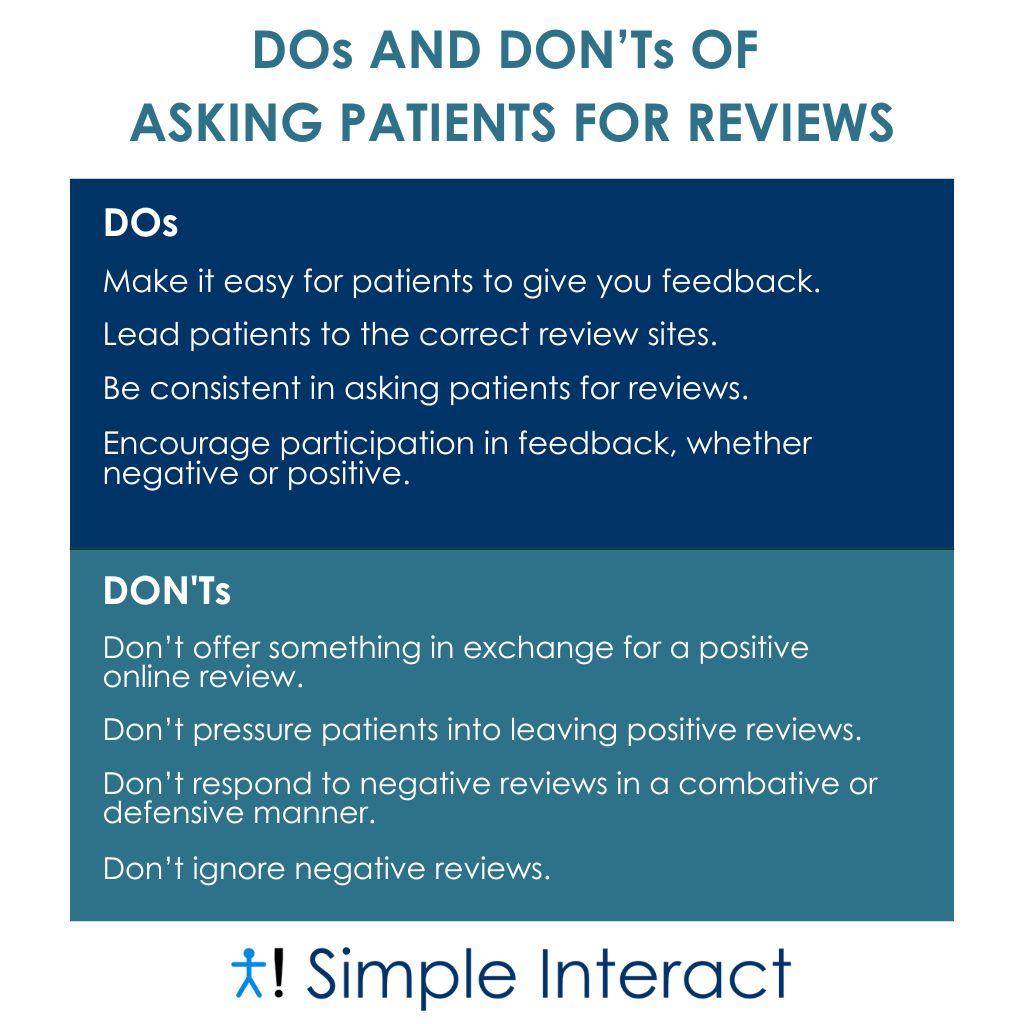4 Dos and Don’ts of Asking for Patient Reviews

We all know that online reviews matter, and this is especially important when it comes to patient reviews of medical providers. What a patient has to say about a medical practice, hospital, FQHC, or practice group can have a significant impact on the reputation of the facility and staff.
One example is the impact that online reputation management had on North Texas Medical Center in Gainesville, Texas. After implementing reputation management software, the center’s Google rating rose from a poor 2.6 to a stellar 4.6! After taking simple steps like asking for patient reviews, they are now the highest-rated hospital in 50 miles.
In another example, one fee-for-service psychiatry practice followed the same process as North Texas Medical Center and received such positive online reviews that patients started driving in from out of their service area to seek treatment — a truly outstanding result.
These examples prove people will seek out the services they perceive as the very best. We consistently see similar results across the board when medical facilities implement reputation management software and follow some basic dos and don’ts of how to ask patients for reviews.
Why Ask Patients for Online Reviews?
Online reviews influence people’s perception of your practice, plain and simple. Potential patients read online reviews to determine whether to book an appointment with you, or move on to your competitor. And more people than ever are relying on these reviews to make important decisions about their healthcare.
So, knowing that getting online reviews is an essential part of growing your organization, you may be wondering how to get more, and more specifically, how to ask patients for reviews.
Let’s review the basic dos and don’ts of this potentially intimidating but ultimately simple process.

Top 4 Don’ts of How to Ask Patients for Reviews
It’s challenging to figure out how to ask patients for reviews, and the process comes with some potential pitfalls. Let’s start with four “don’ts” to help you avoid problems from the start.
1. Don’t offer something in exchange for a positive online review.
Depending on your state, it could be a violation of an existing law. For example, anti-kickback laws, which target unlawful compensation arrangements in medical care, are in place to prevent inflating healthcare costs, unnecessary patient services, and unfair competition. These laws ensure patient care is based solely on medical needs and not on any offered payment or benefit for things like providing an online review.
2. Don’t pressure patients into leaving positive reviews.
Be careful to avoid any implication that you expect a positive review or that a positive review would improve the provider-patient relationship. Not only can this come across as dishonest, but it may also make you seem pushy, unprofessional, and perhaps desperate. The result would be a loss of trust from patients, which likely means they won’t be your patients much longer.
3. Don’t respond to negative reviews in a combative or defensive manner.
When you read a negative review online, it can be tempting to respond in the heat of the moment, especially if you feel the review is unfair or unwarranted. But responding in a combative or defensive manner won’t do you any good; in the eyes of readers, it will actually make you look worse than the review alone.
If you become irritated or upset by a negative review, wait to respond until after you’ve cooled off. Always be professional and courteous in your response. If you’d like to continue your discussion with the patient, take it offline or into a private chat.
4. Don’t ignore negative reviews.
Many healthcare organizations only focus on getting more positive reviews and completely ignore the negative ones. This is a mistake. Negative reviews can actually help you improve your practice.
When patients share negative experiences, and especially if multiple patients share the same negative experience, it provides you with a golden opportunity to fix core issues in your business. Identifying fixable issues and addressing them head-on will help you improve the patient experience and patient retention.
Plus, ignoring negative reviews means you’re missing the opportunity to reach out to those patients to remedy the situation — and possibly get the negative review taken down or edited.
Top 4 Dos of How to Ask Patients for Reviews
Despite the pitfalls mentioned above, the process of asking patients for reviews isn’t as painful as it might seem, especially when you automate many of its aspects.
Now that you know what “don’ts” to avoid, let’s explore four “dos” of how to ask patients for reviews.
1. Make it easy for patients to give feedback.
It may surprise you to learn how many of your patients have no idea how to provide feedback or leave your practice an online review. Take advantage of the contact information you have on file for your patients and send them a simple text or email with a link to a short, mobile-friendly survey for them to provide direct feedback.
2. Lead patients to the correct review sites.
Be sure your patients know the main sites where they can leave a review, such as Google, Facebook, Healthgrades, and WebMD. Provide a direct link to these sites to make the review process as easy as possible.
3. Be consistent in asking patients for reviews.
When it comes to asking patients for reviews, consistency is key. Follow up every patient encounter with a simple request for feedback. Rather than leaving this important step to each provider, have a consistent, automated process in place for requesting patient feedback.
4. Encourage participation in feedback, whether negative or positive.
While positive feedback is wonderful and will improve your organization’s online reputation, negative feedback can be valuable in different ways. As mentioned above, negative reviews are opportunities to improve the patient experience, and they can make you aware of small issues before they become huge problems. They’re also another chance for you to engage directly with patients.
Fixing a perceived problem can turn a one-time visitor into a lifetime patient. The goal is to make patients feel safe to express their feedback and feel heard after doing so. By showing that you’re willing to listen and address negative feedback, you’re likely preventing more negative reviews in the future.
Final Thoughts on How to Ask Patients for Reviews
Following these simple dos and don’ts of how to ask patients for reviews will not only improve your facility’s online reputation, it will also improve the relationship between your patients and their providers.
Simple practices like reputation management can quickly boost your online ratings and grow your business. If you’d like to learn more, get in touch. We’d love to talk.

Ravi Kalidindi is the Founder and CEO of Simple Interact, a leading Front Office Automation company that helps healthcare facilities across the United States run more efficiently and profitably by boosting staff productivity, reducing provider burnout, and elevating the patient experience. Customers view Ravi as a trusted partner who can quickly comprehend business problems and suggest “keep it simple” solutions that are effective and easier to maintain over time.
Recent Posts
- The Benefits of Using 2-Way SMS Chat for Healthcare Communication
- 2-Way SMS vs. Live Chat: Which Is Best for Bi-Directional Patient Communication?
- Simple Interact Earns A+ Satisfaction Ratings in KLAS Report
- Boosting Healthcare Staff Productivity With a Shared Inbox Dashboard
- Healthcare SMS: What Metrics to Track in Your 2-Way SMS
Categories
Archives
- February 2025
- June 2024
- May 2024
- April 2024
- March 2024
- February 2024
- January 2024
- December 2023
- November 2023
- October 2023
- September 2023
- August 2023
- July 2023
- June 2023
- May 2023
- April 2023
- March 2023
- February 2023
- January 2023
- December 2022
- November 2022
- October 2022
- September 2022
- August 2022
- July 2021
- December 2020
- May 2020
- March 2020
- June 2016